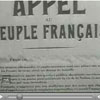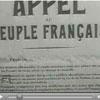National Content: France
The Anglo-American invasion in Normandy
| Source | INA WEBSITE (Institut National de l’Audiovisuel) : ina.fr/archives de guerre (voir et revoir –History and Society –war achives ) |
| Event referred to | City bombing during WWII. June 6th 1944 : D.Day |
| Technological characteristics | Vidéo which can be read by Quickplayer, Real one or Windowmedia (high and low output) |
| Description of the source | Kind of source :.cinematographic news -: French Current events of June 16th 1944 – a 27-second film) and of June 23rd (a 10 minute- 7second film Origin of the source :Ina Website: ina.fr/voir_revoir/guerre/france Language : french (translated into english) Copyright issues :INA 2004 |
| Contextualisation of the source | June 1944 :. The allied landings took place in Normandy. The fighting is taking place on French soil , still governed by Marshal Pétain. (Government of Vichy) – German pictures extracted from Deutsch Wochenschau of Berlin - Vichy Propaganda |
| Interpretation of the source | The Allied forces pressed on French inland as a result of the landings. The stress has been put on the complete destruction of towns; villages and harvest. Victims’ denunciation and war damages caused by the invasion. Appeal to the French people to remain out of this “foreign war” – Denunciation of the Anglo-American terrorist bombardments. The propaganda lead by Vichy towards the French people. Pictures being produced and controled by Germany. Both the Allied losses and the German counter attack have been emphasized. German propaganda. |
| Original Contents | Invasion américaine en Normandie 1er document : 16 juin 1944 http://www.ina.fr/voir_revoir/guerre/france/44-25.fr.html le mardi 6 juin, à 2 heures du matin, les troupes américaines débarquaient sur les cotes de Normandie. Nous vous présenterons au fur et à mesure qu’ils nous parviendrons, les documents de cette bataille, une des plus violentes de tous les temps qui ensanglante une fois encore et si douloureusement la terre de France. 2ème document : 23 juin 1944 http://www.ina.fr/voir_revoir/guerre/france/44-26.fr.html Nuit historique. Les anglo-américains débarquent sur le sol de Normandie. Dans la nuit, des milliers de tonnes d’acier s’abattent sur les navires ou pilonnent les défenses allemandes. Les unités légères prennent pied sur le rivage. Et voici l’aube, au large l’impressionnante flotte anglo-américaine. Durant les premiers jours, plus de 50 navires de transport et des navires spéciaux devaient être envoyés par le fond. D’ici à l’embouchure de l’Orne, on voit nettement les bateaux de débarquement et on distingue les formations qui sont parvenues à gagner la rive. Dans la baie de Seine également, les troupes britanniques tentent de prendre pied ; mais les allemands ont empêchés les anglais d’établir ici une tête de pont et les embarcations ont été jetées à la cote. A l’horizon, la flotte de débarquement. Devant Caen, des chars allemands d’un modèle nouveau se portent au devant des adversaires qui maintiennent et élargissent leur tête de pont en sacrifiant des dizaines de milliers d’hommes. Parallèlement à l’action menée par des unités débarquées, de nombreuses divisions de parachutistes ainsi que des troupes aéroportées lancées au moyen de planeurs atterrissent derrière les lignes allemandes. Dans les champs, dans les bois, des carcasses de planeurs abattus. Ceux- ci ont atterri dans un champ de mines. En 3 jours, 1300 planeurs étaient détruits. Tout avait été minutieusement préparé pour la vaste opération. Les planeurs pouvaient transporter plus de 60 hommes. D’autres transportaient des éléments motorisés légers. Quelques jours après le débarquement, la plupart des troupes aéroportées et des parachutistes sont mis hors de combat. Les cartes sont imprimées en toile.[3mn44] Pendant ce temps, dans le ciel, les escadrilles de la Royal Air Force et de la Luftwaffe se livrent à un duel sans merci. Caen et sa banlieue sous les bombes anglo-américaines. La terre de France est redevenue un champ de bataille. A Caen, impossible de dénombrer les morts. La population fuit épouvantée. Sur 60000 habitants, 7000 vivent encore dans les ruines. Les autres comme aujourd’hui tant de français connaissent un nouvel exode. Derrière les lignes, le calvaire de la France a commencé. Et voici Lisieux après 22 minutes de bombardements. Un paysage lunaire, rappelant les ruines de Pompéi. La ville n’est plus qu’un nom géographique. 16000 habitants, 12000 sinistrés, près de 3000 morts. Ici un pensionnat où 14 jeunes filles sont ensevelies. Là dans des grottes vivent les rescapés. Durant des jours, le secours national a du nourri la totalité des habitants car notre pays possède encore des hommes qui savent donner toute leur activité, toute leur âme au service des français malheureux. Après Lisieux, près Saint Lo, après Vire, Evreux a terriblement souffert. Dans chaque camp, les combattants connaîtront sans doute des fortunes diverses, mais hélas les français ne connaîtront eux que des deuils et de nouvelles souffrances. Cependant, ainsi que nous le recommandait le Maréchal, n’écoutez pas ceux qui cherchent à exploiter votre détresse, cela conduirait votre pays au désastre. Français, restez calme et disciplinés. Suivez les consignes du Président Laval. Vous refuserez d’entendre les appels insidieux qui vous seront adressés. Vous vous refuserez à aggraver la guerre étrangère sur notre sol par l’horreur de la guerre civile.[7 mn 16] Cependant sans relâche, les divisions allemandes blindées montent en ligne. La bataille se développe à travers la campagne normande. Ici, hélas, il n’y aura pas de récolte. En une semaine, 400 tanks anglo-américains ont été mis hors de combat. Protégé par l’artillerie lourde de leurs cuirassés, les assaillants ; après 12 jours de combats meurtriers sont parvenus à s’établir sur une bande de terrain longue de 100 kilomètres. Et toujours, partout, implacablement, en regardant ces images de bataille, nous retrouvons le martyr d’une de nos plus riches provinces. Les combattants vont se battre pour ces champs brûlés, pour ces pans de mur, pour ces villages français qu’ils soient pris et repris. Après des mois de bombardements terroristes, notre pays connaît à nouveau ce drame atroce : la guerre, la guerre sur notre sol, la guerre et son abominable cortège de crimes, de désolation et de mort. |
| Original Contents (English Translation) | The American invasion in NORMANDY 1st document : June 16th 1944 http://www.ina.fr/voir_revoir/guerre/france/44-25.fr.html On Tuesday, June 16th at 2 o’clock in the morning, the American troops were landing on the Norman Coasts. We will present you the documents of this battle as soon as they reach us :one of the most violent battle from time immemorial which once again, is bathing so painfully our French soil in blood. 2nd document : June 23rd 1944. http://www.ina.fr/voir_revoir/guerre/france/44-26.fr.html Historic night : The Anglo-American are landing on the Norman soil. During the night, thousands of tons of steel are beating down on the ships or are bombarding the German defense. The light units are setting foot on the shore, and here at dawn, we can see the impressive Anglo-American fleet in the open sea. More than 50 transportation vessels and warships had to be sent to the bottom during the first days. From here to the mouth of the Orne, the vessels intended for the landing can clearly be seen including the formations which have succeeded in reaching the shore. As for the British troops, they are attempting to land in the Baie de Seine too, but they are prevented by the Germans from setting a bridgehead at this area, and the boats have been thrown on the coasts. The landing fleet can be seen on the horizon. In front of Caen, new models of German tanks are carrying themselves to the front, being faced with the enemies who are maintaining and widening the bridgehead, sacrifying tens of thousands of men. At the same time, parallel to the actions lead by landed units, lots of divisions of paratroopers and airborne troops launched with gliders are landing behind the German lines. Skeletons of shot down gliders have been scattered in the fields, in forests. These gliders have landed in a minefield. 1,300 gliders have been destroyed in 3 days. Every thing had been meticulously prepared for that huge operation. The gliders could carry more than 60 men. Some others could carry ligh motorized elements. Some days after the landing, most of the airborne troops and paratroopers have been put ouf of action. The maps are printed in canvas.[3’44] Meanwhile, in the sky, the Royal Air Force’s and the Luftwaffe’s squadrons are fighting ruthlessly. The city of CAEN and its suburb are under the Anglo-American bombs. The French soil has become a real battleground, once again. It is impossible to count the dead. The terrified population is fleeing. 7,000 inhabitants ouf of 60,000 are still living in the ruins. The other ones, like so many French people are experiencing a new flight. Behind the lines, the French martyrdom has begun. And here the city of LISIEUX after a twenty-two minute- bombardment. Lisieux has been turned into a lunar landscape, reminding of Pompei’s ruins. The city is nothing else but a geographic name. 1,600 inhabitants, 12,000 disaster victims, almost 3,000 dead. At that spot, there used to be a boarding school where 14 young girls have been buried. There, some caves in which survivors live. The National Relief had to feed all the inhabitants for several days, for our country still possesses men who are willing to give their whole activity, their whole soul in the service of the unfortunate French people. Right after Lisieux, Saint Lo, then Vire, the City of Evreux has awfully suffered. In every camp, undoubtedly, the fighters will know varying fortunes but alas, as for the French, they wil know nothing else but mourning and new sufferings. Yet, as we have been recommended by the Marshal, do not listen to those who try to exploit your distress, otherwise your country would be heading straight for disaster. French, keep your composure and be well-disciplined. Follow President Laval’s instructions. You will pay no attenton to the insidious appeals you will be addressed. You will refuse to worsen the foreign war on our ground with the horror of the civil war. [7’16] Nevertheless, the German armoured divisions are going off to war relentlessly. The battle is spreading out through the Norman countryside. Alas, in this area, there will be no harvest. 400 Anglo-American tanks have been put out of action in a week. The assailants who were protected by the heavy artillery of their amoured cavalry men, have succeeded in taking up position on a strip of land 100 km long, after a 12-day-deadly fight. And still, every where, when looking at these battle pictures, we implacably recognize the martyrdom of one of our richest provinces. Fighters will fight for the sake of these burnt fields, these wall sections, these French villages. After months of terrorist bombings, our country is going through that dreadful tragedy, once again : war : the war on our ground, the war with its appalling series of crimes, devastation and death. |

